
It is important to follow a species-appropriate diet. This is true for humans as well as for dogs, especially since the appearance of processed food.
From a genetic standpoint, domesticated canines and felines are essentially the same as their wild counterparts, who are carnivores. This means that dogs evolved to consume a low-carbohydrate diet. Since they are carnivorous animals, they must eat fresh whole prey for optimal health.
But for the last century, the majority of dog owners have fed their dogs a high-carbohydrate, low-moisture diet, i.e. commercial pet food. This new diet has created significant metabolic and physiologic stress in our dogs. It has even become the root cause of most of the inflammatory processes and degenerative disease we see in veterinary medicine today.
In this dog nutrition guide, I will talk about:
Essential Nutrients for Your Dog
Before thinking of what to give your dog to eat, let’s look at what nutrients dogs need in their diet to be healthy.
Whether you buy your dog food or make it yourself, your dog needs a balanced diet which is species-appropriate to stay healthy. That kind of diet includes a mix of:
- Proteins.
- Fats.
- Vitamins.
- Minerals.
- Water.
Proteins
Protein is a macronutrient.
Protein Importance
- Protein supplies essential and non-essential amino acids that are critical to life.
- They give the body structure (strong hair, skin, nails, muscles and bones, for instance).
- Also, they are necessary to make hormones, neurotransmitters, enzymes and antibodies that keep the body functioning optimally.
Note: Growing puppies and pregnant and lactating females require about twice as much protein as an adult dog at maintenance.
Protein Sources
- Animal sources: Lean-muscle meats, fish and eggs.
- Plant-based sources: Beans and lentils.
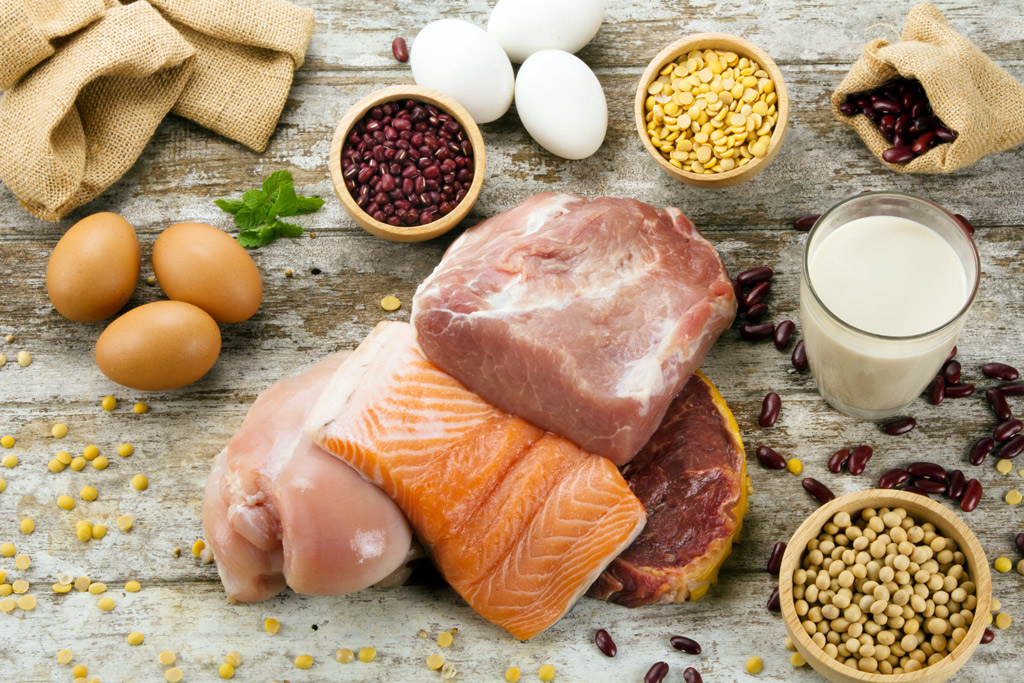
Fats
Fat is a macronutrient made up of fatty acids. Dietary fats are either:
- Saturated (e.g., butter, cheese).
- Polyunsaturated (e.g., fish oil, flaxseed oil, sunflower oil).
- Monounsaturated (e.g., olive oil).
Fat Importance
- Fats give your dog energy.
- They also help keep your dog’s skin and hair healthy.
- They provide essential omega-3 and omega-6 fatty acids, which enables:
- Absorption of fat-soluble vitamins.
- Protects internal organs.
- Regulates body temperature.
- Promotes a healthy nervous system.
Fat Sources
- Low-mercury fish like salmon and sardines.
- Fish oil like krill oil.
- Plant-based oils, such as flaxseed and hempseed.
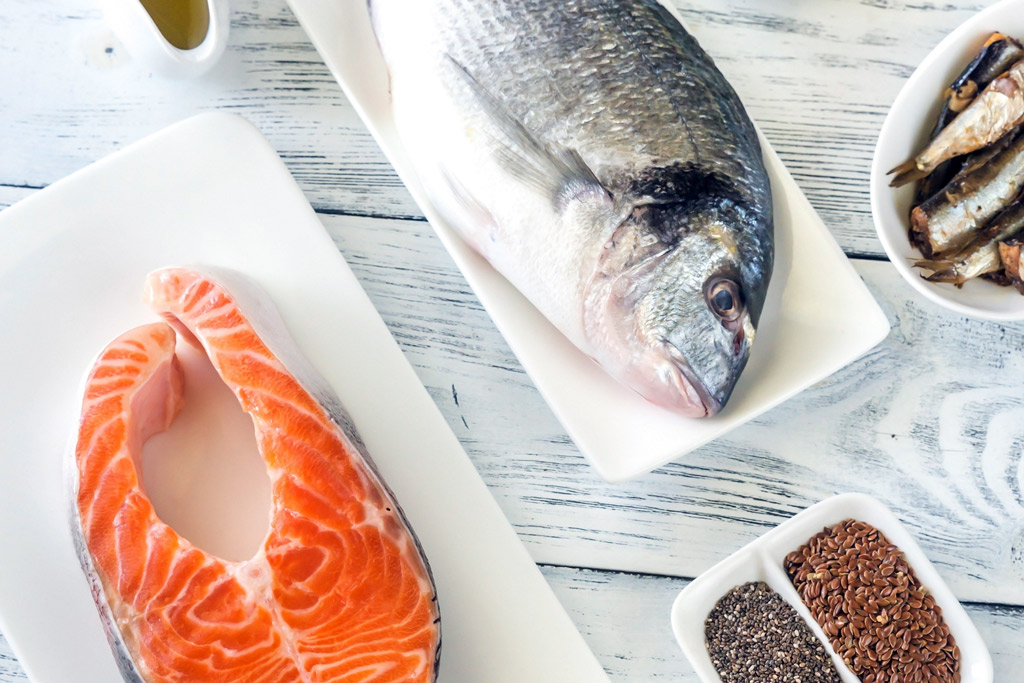
Vitamins
Vitamins are organic compounds (i.e. they contain carbon) and are required in small quantities for proper metabolic function.
Vitamins can be soluble in fat (A, D, E and K) or in water (B and C). Fat-soluble vitamins are stored in fatty tissues and the liver; water-soluble vitamins are not stored.
Vitamin Importance
Vitamins play a variety of critical roles, including:
- Regulating calcium and phosphorus levels (Vitamin D).
- Boosting the immune system (Vitamin A).
- Serving as antioxidants (Vitamins C and E).
- Enabling the blood to clot (Vitamin K).
- Maintaining nervous system function (Vitamin B12).
Vitamin Sources
- A varied diet containing organ and muscle meats.
- Dog-friendly plant-based foods such as dark leafy greens.
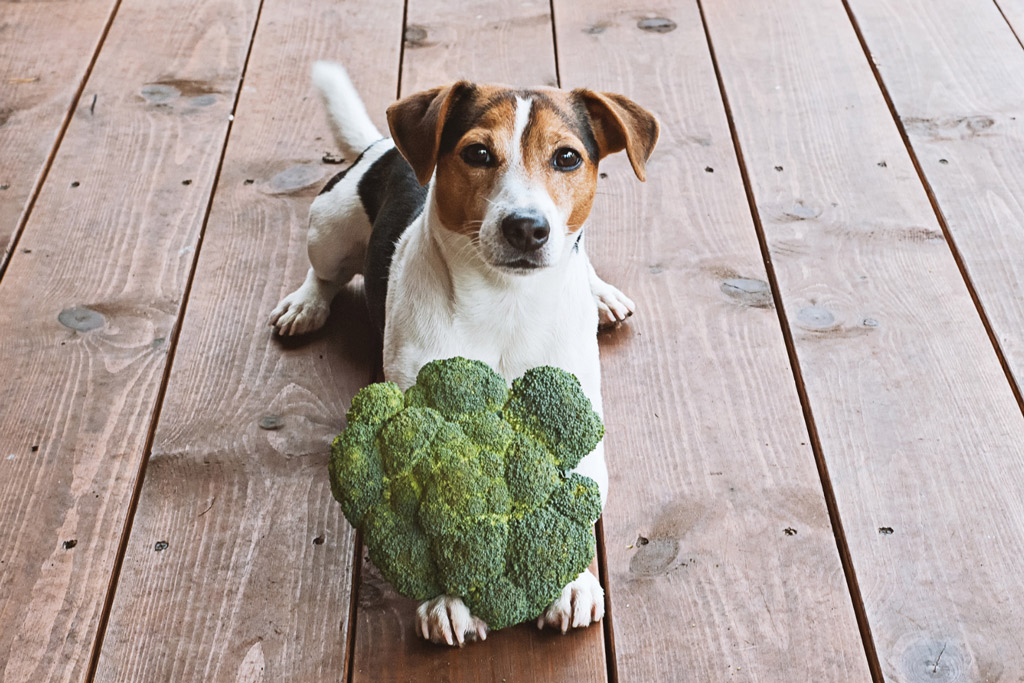
Minerals
Minerals are inorganic compounds that the body needs to maintain proper metabolic functions. The body cannot manufacture minerals and so must get them from food.
There are two classes of minerals:
- Macrominerals (calcium, magnesium, phosphorus, sodium, potassium, chloride).
- Microminerals (iron, copper, zinc, manganese, selenium, iodine).
Macrominerals are required at higher levels than microminerals, but both types are equally important.
Mineral Importance
Like vitamins, minerals perform a variety of functions in the body that are essential for supporting life, including:
- Constituting a major part of bones (calcium, phosphorus).
- Carrying oxygen throughout the body (iron).
- Assisting in wound healing (zinc).
- Providing antioxidant support (selenium).
- Aiding in nerve transmission (sodium, potassium, calcium, magnesium).
- Regulating fluid balance (sodium, chloride, potassium).
Note: Growing puppies require more than double the calcium of adult dogs at maintenance. However, calcium and phosphorus levels must be monitored closely in large-breed puppies to avoid the risk of developmental orthopaedic disease.
Mineral Sources
Different foods are rich in different minerals:
- Meat is high in phosphorus.
- Bone is high in calcium.
- Organ meats provide copper and iron.
- Shellfish is rich in zinc.
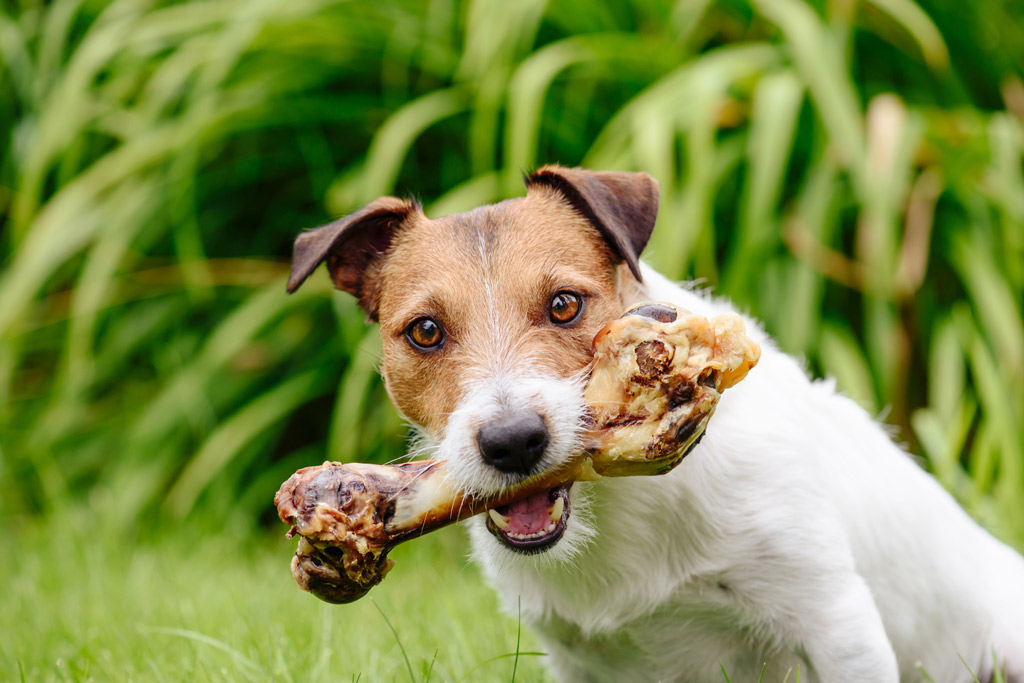
Water
A tasteless, colourless, odourless chemical made up of two hydrogen molecules and one oxygen molecule (H2O).
Water Importance
- Without water, life cannot exist. It is so important that your dog could die if he or she loses only 10% of the water in his body.
- Water makes up 70 to 80% of a mature dog’s lean body mass.
- Water’s many important functions include:
- Dissolving and transporting nutrients to the cells.
- Helping regulate body temperature.
- Hydrolyzing protein, fat and carbohydrates for digestion.
- Cushioning the organs and nervous system.
- Flushing waste from the body.
Water Sources
Make sure your dog always has fresh, clean water available. You can get it straight from the tap fitted with a good quality filter.
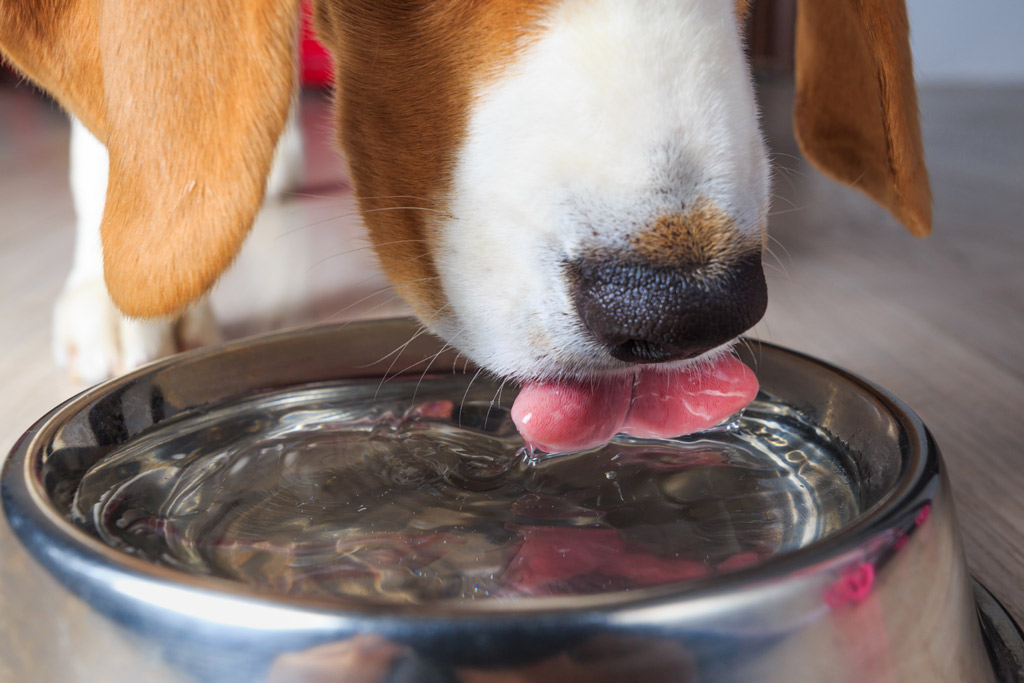
Balanced Dog Meals
So how can you make sure that your dog gets all the nutrients needed for a healthy and long life?
A Balanced and Species-Appropriate Diet
A healthy, species-appropriate dog diet should include:
- High-quality protein – muscle meat, not pieces or parts.
- Moderate level of animal fat.
- High levels of EPA and DHA (omega-3s).
- High moisture content.
- A few fresh cut veggies (mimics prey’s stomach contents).
- No fillers like grains, corn, potatoes or other starches.
Plus, your furry friend should be well hydrated.
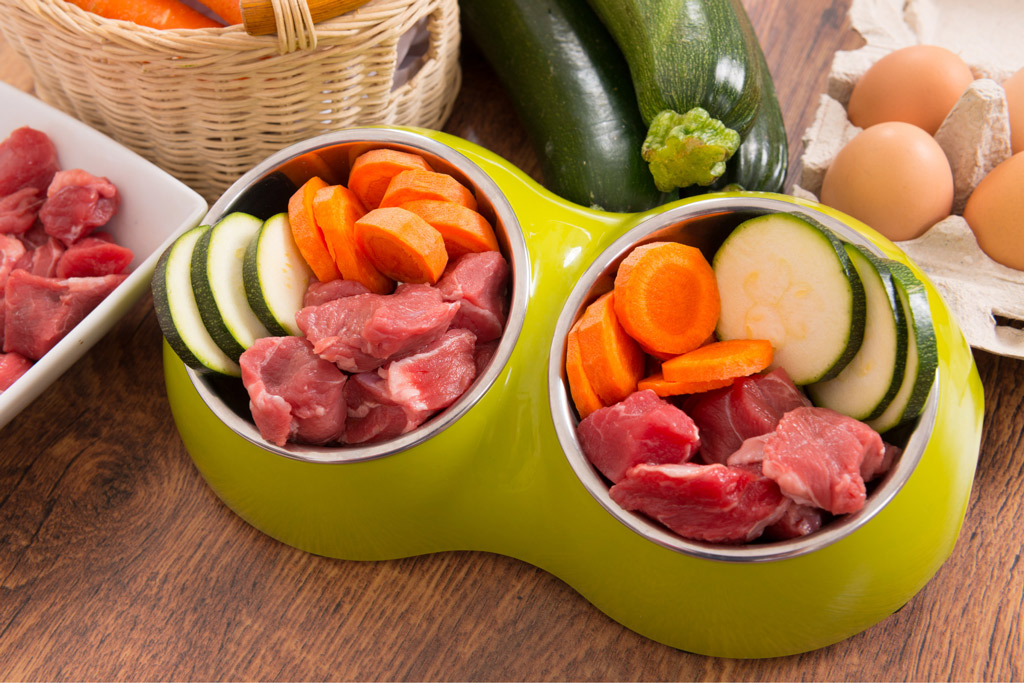
Supplementing a Dog’s Diet
Food doesn’t always contain all the nutrients your dog needs, it doesn’t matter if it’s commercial or homemade. High-quality and natural dietary supplements can be extremely beneficial to your dog’s health and longevity. Plus, they guarantee that your dog is getting the right nutrients.
Here are some natural supplements that can help your dog:
- Probiotics and Digestive Enzymes capsules: For the gastro-intestinal (GI) tract health.*
Curcumin/Tumeric capsules and Chlorella: For liver and kidney health.* - CoQ10: For the heart.
- Collagen: For joint health.
- MCT Oil: For cognitive health.
- Krill Oil: For skin and coat health.
*Note: the links above will take you to Amazon.
If you want to know more about natural dog supplements, check our Natural Dog Supplements with Health Benefits You Must Know About blog post.
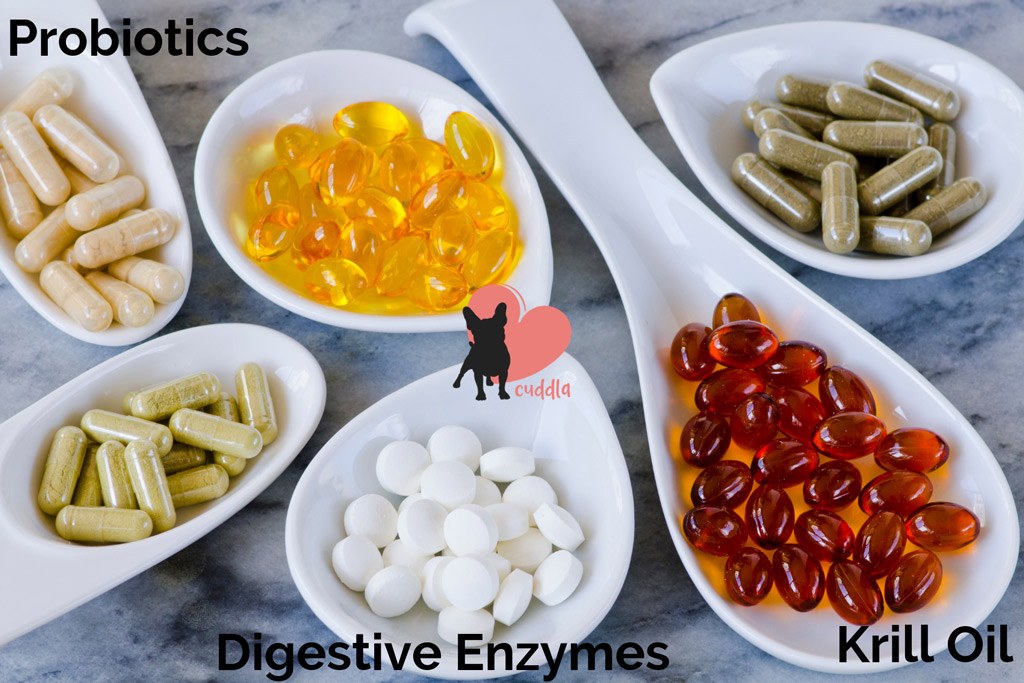
Dog Meal Plan
As a general rule of thumb, the amount you feed your dog should be based on:
- Size.
- Age.
- Bodyweight.
- Metabolism.
- Energy levels.
Here’s the basic formula to calculate daily calorie intake:
| Canine Daily Calories = Body Weight (kg) x 30 + 70 |
For example, puppies need milk as a major food item while an adult dog will need beef. Also, depending on your dog’s age, the meal schedule varies (refer to Feeding Schedule).
Overfeeding your dog will lead to obesity problems and other health issues.
Dog Meal Plan for Puppies
Puppies should not be separated from their mom before they are eight weeks old, so they get all the nutrients they need to grow from their mum. However, if you find yourself having to feed an orphaned puppy, 5% of his body weight may be taken as food quantity measure.
Puppies need greater amounts of protein and fat than adult dogs. Also, unlike adult dogs, puppies need to be fed restricted amounts of food but with more frequency. Once they get older, the amount will be increased but the frequency of feeding is often decreased in many occasions.
Most of a puppy’s growth occurs by 6 or 7 months of age, but large and giant breeds can continue to grow for 12 months or beyond.
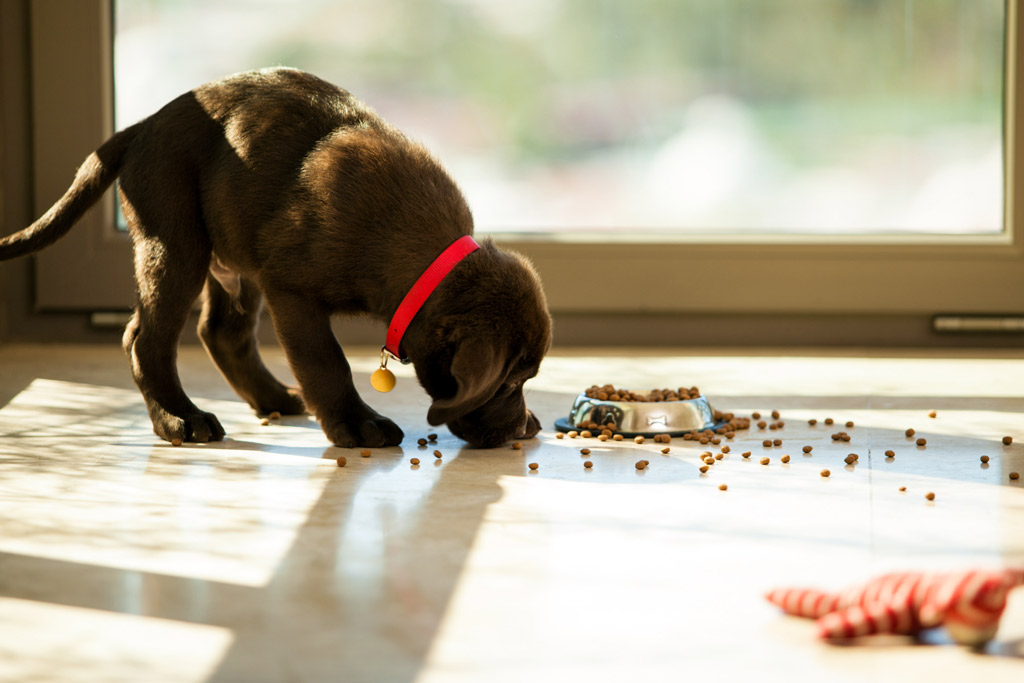
Dog Meal Plan for Adult Dogs
When a dog reaches 90% of its expected adult weight, it’s considered an adult for feeding purposes.
You can use the Canine Daily Calories formula as a guideline, and adjust it according to your dog’s energy levels.
- Lapdogs who get little exercise may need 10% less than what’s recommended.
- An active dog that exercises outdoors may need 20% to 40% more.
If your dog has any health condition, talk to your vet to adjust your dog’s diet accordingly, including the daily intake of food.
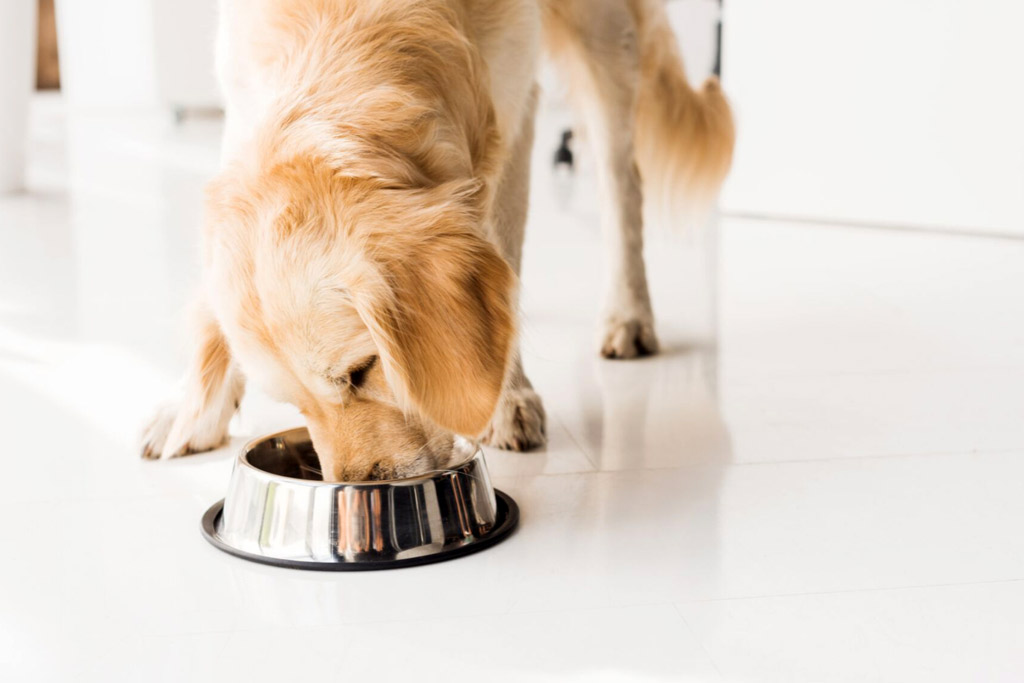
Dog Meal Plan for Senior Dogs
Senior dogs need restricted protein but the protein needs to be easily digestible and easily assimilated in the body.
Feeding them too much protein may finally lead to overburden their renal structures and ultimately, the dog may end up damaging the filters in their kidney. This is true especially when the immune system of these dogs is compromised due to many factors.
They also need less food because their movements are highly restricted (they are not as active as puppies or adult dogs); hence, they have to spend a limited amount of energy.
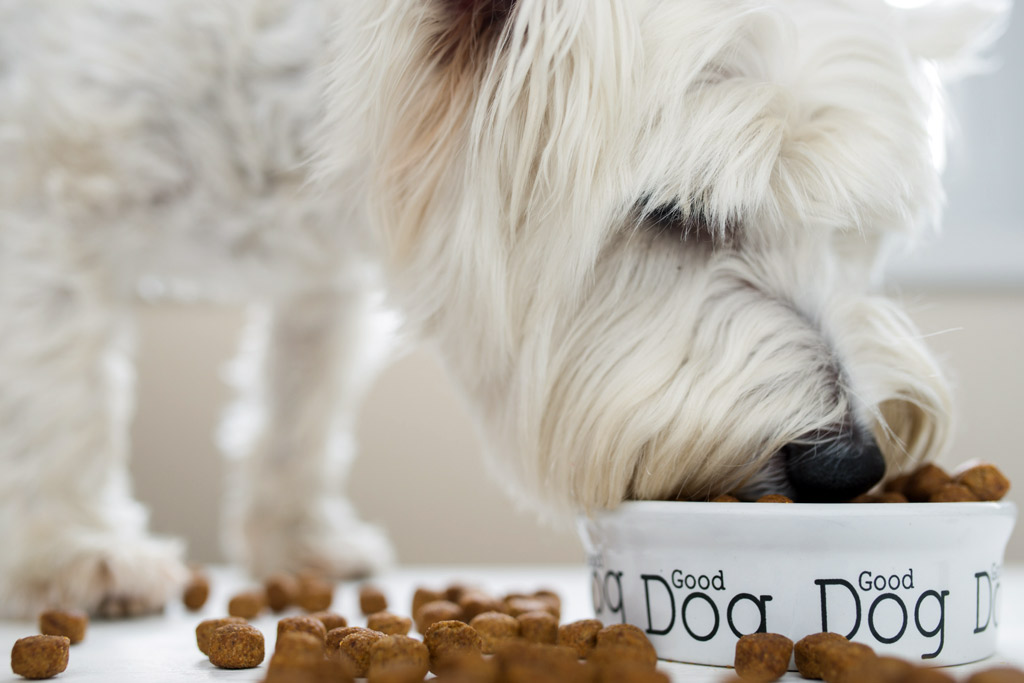
Dog Meal Plan for Pregnant and Nursing Dogs
Female dogs during pregnancy stage need not be fed a full stomach since it may cause some discomforts to them. However, all pregnant and nursing dogs need a special type of foods that deliver a balanced type of nutrition with proper supplementation of vitamins and minerals.
A nursing dam with puppies needs to be fed with enough amounts of calcium so there will not be any calcium based deficiency and the bones of her puppies will be strong, without any curving.

Feeding Schedule
Again, the feeding schedule and the number of times you feed your dog depends on the dog’s age.
Plus, setting a feeding schedule will help your dog since they thrive with consistency.
Feeding Schedule for Puppies
1 To 6 Weeks of Age
Puppies need to be feed milk five to seven times per day. They will probably make some sound if they get hungry.
Once puppies are 4 weeks old, they might start taking some solid food.
6 Weeks To 12 Months
After puppies are 6 weeks old, their feeding frequency may be reduced. Between 8 weeks to 12 months, you can feed your puppy twice a day: breakfast and dinner. Beware that your pup will be teething around 3 to 6 months of age.
Feeding Schedule for Adult Dogs
Most dogs owners prefer feeding an adult dog twice a day, although a dog can eat just once daily. Giving two meals a day may make it easier for the dog to digest the food (avoiding getting bloated) and helps control hunger.
Feeding Schedule Tips
- You can divide the total amount of calories into two meals and space them during the day; you can give your dog breakfast and dinner, for example.
- You can practice timed feeding, removing the food bowl after 30 minutes, regardless of food being left in it.
- Also, you can divide your dog’s meal into farther portions using a stuffed toy like a Kong (Amazon link). This is a great solution to keep your dog entertained when you are not around. This works for all dogs (puppies, adult and senior dogs).
Feeding Schedule for Senior Dogs
Dogs begin to show visible age-related changes at about seven to 12 years of age. They also go through some metabolic, immunologic and body composition changes, too. Some of these may be unavoidable while others can be managed with diet.
When feeding your older dog, the main objective should be to maintain health and optimum body weight. This can help to slow down the development of chronic disease and minimize diseases that may already be present.
Also, you can feed older dogs twice a day to encourage easier digestion.
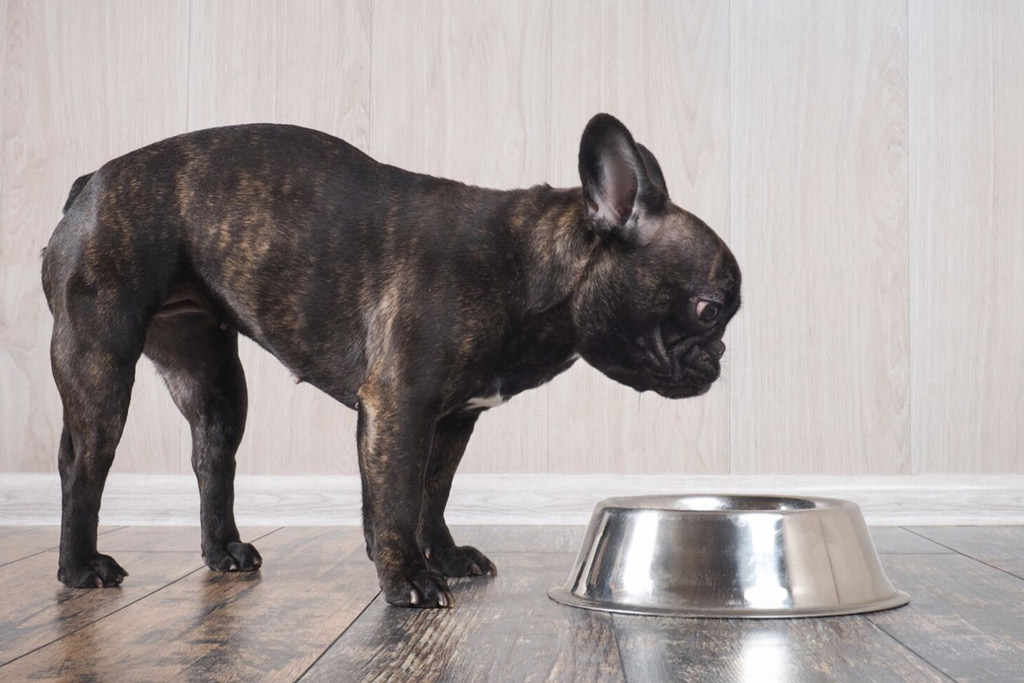
Drinking Schedule
All dogs should always have access to clean and fresh water.
A dog’s water requirements vary based on health, activity level and environmental temperature. Most dogs self-regulate their water intake to meet their needs.
However, some either under-drink or over-drink. Too little water can lead to dehydration, kidney stones, organ failure and even death. On the contrary, drinking too much water can lead to stomach bloat, electrolyte imbalances, and hyponatremia (water toxicity). That’s why its good to keep an eye on the water bowl level.
Insider Tip: Dogs fed high-moisture foods typically drink less than kibble-fed dogs.
Dog Drinking Guidelines
So, how much water should a dog drink a day?
Here are some optimal guidelines to know how much water your dog should drink daily:
- Size: On average, a healthy dog drinks about 1/2 to 1 ounce of water per pound of body weight per day.
- Food: A healthy diet is as important as water and the type of food your dog eats affects their water intake. Also, avoid ingredients that can artificially increase your dog’s thirst such as sodium.
- Age: Puppies need about a 1/2 cup every two hours and need to be closely monitored. Adult dogs tend to naturally monitor themselves.
- Exercise: Bring water along on any exercise excursion with your dog. After exercise, just give him little water at a time to prevent bloat.
- Weather: Hot summer weather means more panting, i.e. dog’s experience an increase in water intake.
- Medications: Check with your vet to see if you need to decrease or increase your dog’s water intake while taking a medication.
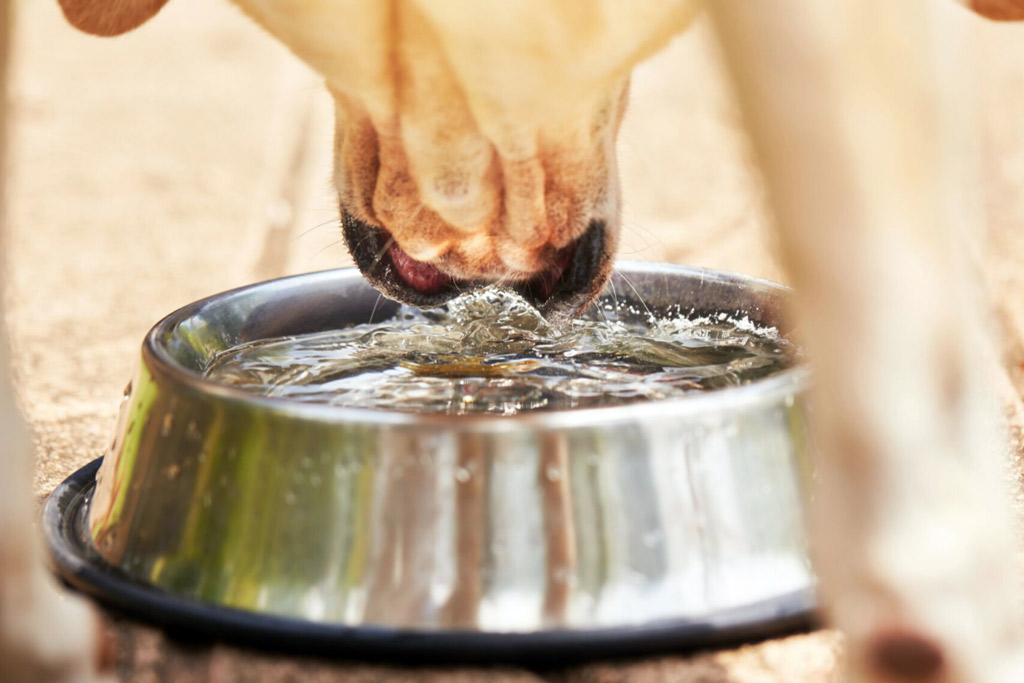
Types of Dog Food
Once knowing what nutrients your dog needs to stay healthy, the next step is to understand what dog food contains, so you can choose what’s best.
Dog food can be dry or fresh. Also, it is important to understand the moisture status. Your dog might prefer more moist food, so you can pay attention to your friend’s preferences.
There are five types of food that you can give your pooch:
Commercial or processed dog food:
- Kibble.
- Canned.
- Semi-moist.
Homemade dog food:
- Home-cooked.
- Raw.
Processed Dog Food
What’s also very important for dog owners to know is that processed dog food is a relatively new concept. So, the dog food you buy from the supermarket has only been around a little over a hundred years.
The truth is that our pet population provides a place for recycling waste from the human food industry:
- Grains that fail inspection.
- Uninspected pieces and parts of waste from the seafood industry.
- Leftover restaurant grease.
- Diseased livestock.
- And even roadkill.
All those leftovers are collected and disposed of through rendering — a process that converts all sorts of human food industry waste into raw materials for the pet food industry. Then, they add bulk vitamin and mineral supplements. Finally, they extrude the mix at high temperatures, creating all sorts of toxic reactions.
Ingredients In Processed Dog Food
Processed dog food producers are focused on grain-based dog food, even if dogs are carnivorous, not vegetarian.
As part of a vegetarian-based dog diet, you can find beet pulp, pasta, soybean oil, wheat middlings, calcium carbonate, magnesium oxide, copper sulphate, iron sulphate, zinc oxide, choline chloride, etc.
However, raw egg, chicken, beef, mutton, fish, quail, etc. are the appropriate foods for your dog’s regular diet.
Many premium types of dog food preparations contain essential fatty acids, carbohydrates with adequate fibre contents, vitamins like A, D, E and B complex vitamins.
However, these prepared foods have a lack of minerals since the cost of doing so is comparatively more expensive than regular food preparations with general ingredients.
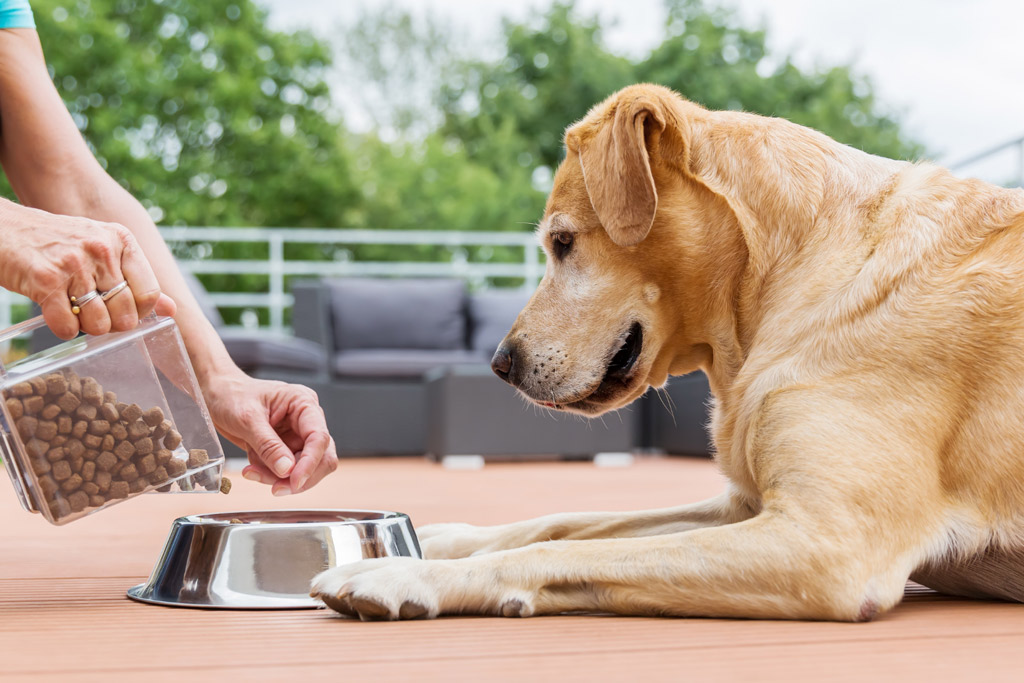
#1 – Kibble
Dry food known as kibble is the most economical type of commercial dog food, and this is the reason that many owners choose it for their doggies.
Also, it lasts for a longer time, compared to the other options, and doesn’t need to be refrigerated.
It’s a belief that dry food can also help to keep your dog’s teeth stay healthy. It’s true that chewing hard food helps to reduce tartar buildup, but the ingredients in dry food might do more harm than good.
Insider Tip: When choosing kibble, go for:
– Rich in animal protein (primary ingredient).
– Limited ingredients (to avoid filers).
– Grain-free. (so they get quality protein) and it’s grain-free.
Have a look at the range of dog wholesome food on Amazon.
#2 – Canned
Most dogs love canned food because it’s wet. It has a long shelf life and is easy to find at any supermarket, but it can be expensive.
Also, most canned food is about 75% water. The higher the water content, the less nutrient content, so the more food your dog must consume in order to get the nutritional value his body needs.
Insider Tip: When choosing canned food, look for a brand that provides the protein that your dog needs, a digestible protein, not one ingestible one (which will pass through your dog’s system without being broken down into absorbable nutrients).
#3 – Semi-Moist
Commercial dog foods shaped like pork chops, burgers, or other meaty foods are called semi-moist foods.
These can be the least nutritional of all dog foods because they contain many artificial flavours and colourings. They shouldn’t be considered a diet because they do not provide the essential nutrients that your doggy requires.
Dry Kibble vs. Moist Canned Food
Dogs like dry foods only if they are tasty. Generally, they prefer canned food because of the moisture. It is about 70 to 80% in canned food, but only 10% in the dry food.
If we look at the nutrients, often dry food contains nearly 90% nutrients whereas canned food contains less. That’s why to have a balanced diet with all the necessary nutrients, it’s best to give a variety of foods to your doggy, not just dry food all the time.
Many dry foods are soybean, corn and/or rice-based. Canned food is based on beef or chicken along with mineral and vitamin supplements suited for the upkeep of your dog’s health.

Homemade Food
Homemade meals provide the guarantee of freshness in the preparation and ingredients, unlike the ready-made commercial items. Homemade fresh dog food generally consists of ingredients like freshly cut chicken pieces in addition to coconut oil, blue-green algae, etc.
They lack the harmfull ingredients that processed dog foods have. Usually, commercial diets have artificial colouring agents, flavouring agents and preservatives that are harmful to your dog’s body.
Often, these homemade meals are prepared using freezing procedures to kill the germs or by adding grape seed extracts to provide sufficient antioxidants. Apple cider vinegar is also added to meat pieces prepared in a fresh manner.
Also, you are in complete control of their dog’s diet. A homemade diet allows you to know for certain exactly what is in everything your pooch eats and how is prepared.
#4 – Home-Cooked
Feeding your dog a home-cooked diet is time-consuming and expensive, but some dog parents think is worth the peace of mind they gain by doing so.
If you feed your dog a home-cooked diet, make sure you don’t miss out on the essential nutrients mentioned before.
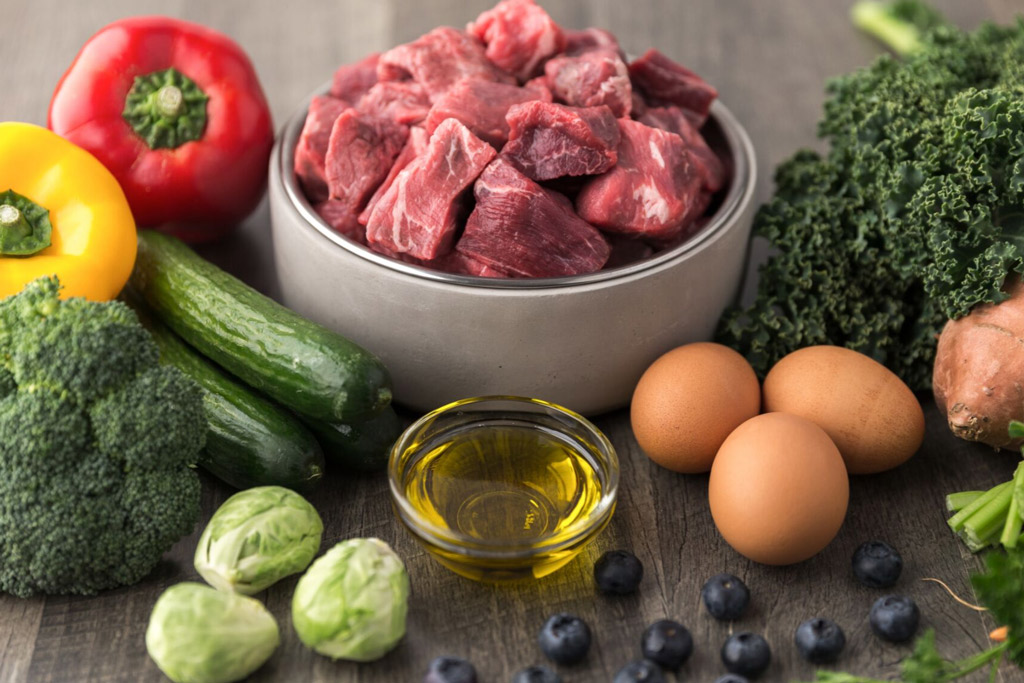
#5 – Raw
A raw diet consists of raw meat, with some organs (like liver) and bones (but never cooked bones, only raw).
Bones are a natural source of phosphorus and calcium and good for their teeth. Also, raw meat is a great source of protein.
This type of diet can work well for many dogs since dogs have short intestinal tracts and strong stomach acids, both of which make it easy for them to consume and digest raw food. However, before implementing any kind of raw food, talk to your veterinarian about the benefits and risks.
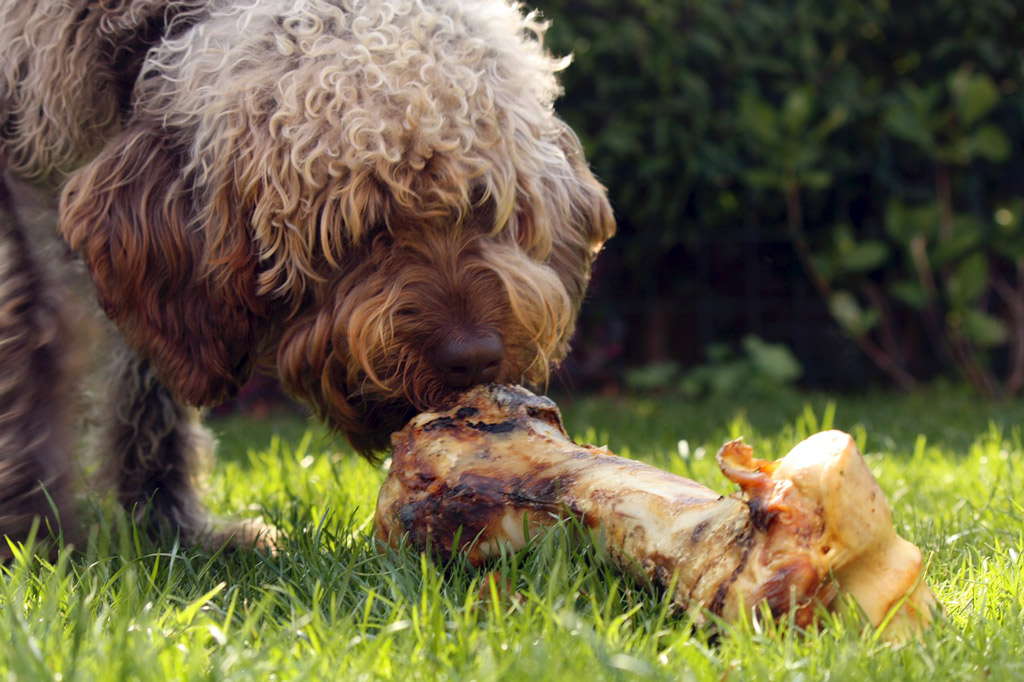
Toxic Foods for Dogs
Dogs can be opportunists when it comes to getting their paws on tasty treats. However, not all everyday foods and drinks are safe if they come into contact with them.
So, if what we eat on a daily basis can be toxic food for your pooch, let’s have a look at the nine foods are particularly dangerous to dogs.
#1 – Onions, Garlic and Chives
Plants containing allium, including onions, garlic, leeks and chives. However, dogs can safely consume 1/4 teaspoon of freshly chopped garlic per 15 pounds of body weight since it has substantial health benefits.
The onion family is particularly toxic and can cause gastrointestinal irritation and red blood cell damage. Signs of illness are not always immediate and can occur up to a few days later.
#2 – Chocolate and Chocolate-Based Products
It’s irresistible for both humans and pets. However, chocolate is another poisonous food for dogs. It contains a stimulant called theobromine (dark chocolate has the highest content of this) which can cause kidney failure.
#3 – Macadamia Nuts
Macadamia nuts contain a toxin that can affect your dog’s muscles and nervous system resulting in weakness, swollen limbs and panting.
#4 – Corn On The Cob
Corn on the cob could potentially be fatal if eaten by your dog. Although the corn is digested by dogs, the cob can cause a blockage in your dog’s intestine.
#5 – Avocado
Avocados are another poisonous food. They contain a substance called Persin, which is in its leaves, fruit, and seed. This substance can cause vomiting and diarrhoea.
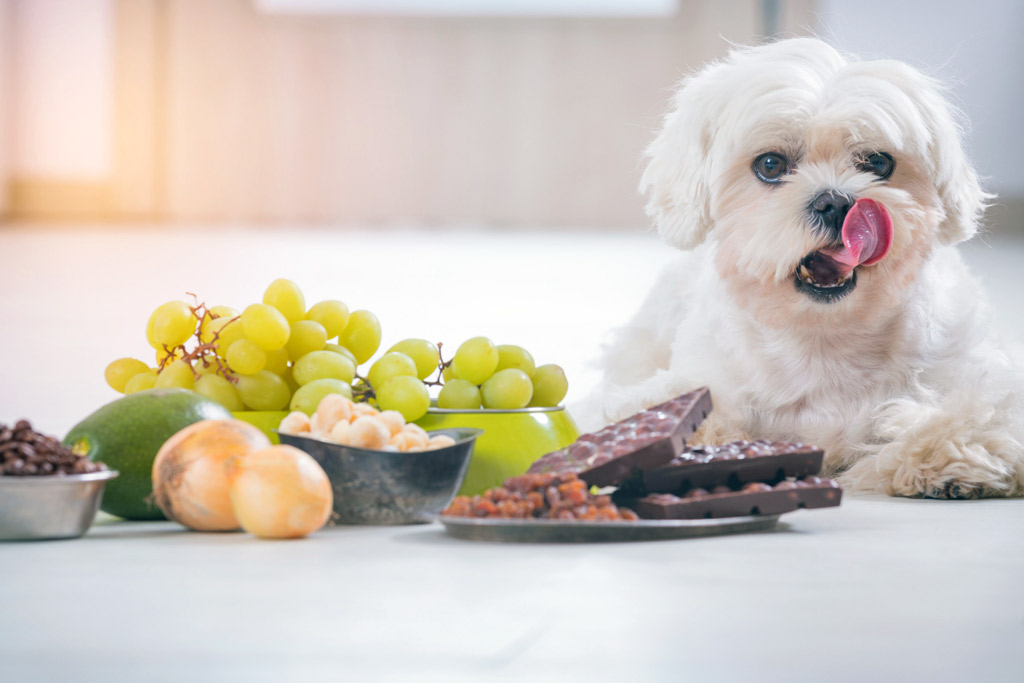
#6 – Sugar and Artificial Sweetener
All sugars and artificial sweeteners, including xylitol, are harmful to your pet. Many foods like sweet treats, drinks, sugar-free products, etc. often have an artificial sweetener called Xylitol.
Xylitol causes an insulin release in our bodies. However, if your dog digests one of these sweetened foods they can go into hypoglycemia, which is linked to liver failure and blood clotting disorders.
#7 – Alcohol
Alcohol, in particular, Ethanol in alcoholic beverages has a huge impact on pets even in small doses. The drink not only causes intoxication as it does in humans, but it can lead to sickness, diarrhoea, and even central nervous system damage.
#8 – Cooked Bones
Giving your dog a raw uncooked bone to chew on is great, but avoid cooked bones at all cost. These can easily splinter and in large quantities cause constipation or at worst, perforation of the gut which can be fatal.
#9 – Grapes and Raisins
Vitis vinifera fruits, including grapes, raisins, sultanas and currants are also poisonous. The active ingredient which causes the toxin is unknown, however, these four fruits may cause severe liver damage and kidney failure.
What should I do if my dog has eaten any of these?
If consumed, even small amounts of these items can be fatal so always act immediately and take your dog to the vets.
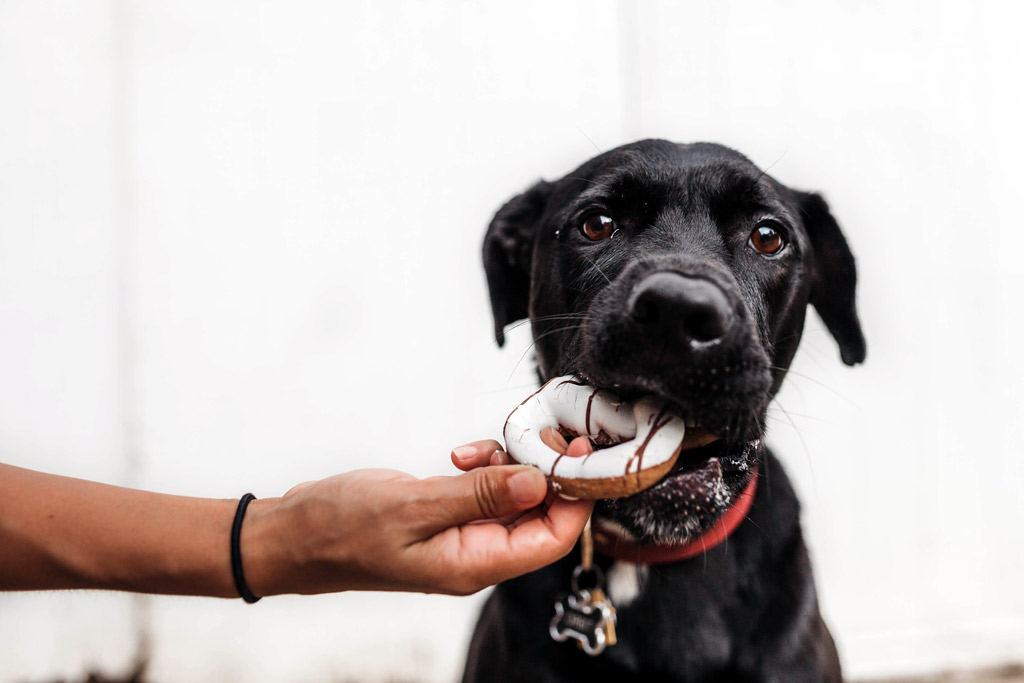
Dog Food Allergies
Food allergies are something that is difficult to identify unless one is well aware of the baseline information with regard to this type of allergy.
Allergic reactions mostly involve the skin or the gastrointestinal tract. The main symptoms of food allergies in dogs include:
- Facial itching.
- Limb chewing.
- Belly itching.
- Recurrent ear infections.
- Skin infections.
If dogs consume a lot of prepared foods including various kinds of proteins, fillers, colouring agents and more, the incidences of food allergies are more than one can imagine.
If you come across your dog itching after having food, then it could be a food allergy. However, conditions like fungal infections need to be ruled out before assuming that the itching is a sign of food allergy.
There are many recorded incidences of allergies to corn and wheat. However, food allergies can vary from dog to dog. Read the labels carefully if you suspect your dog is allergic.
Insider Tip: If you come across any different kinds of preservatives and if the dog develops all of a sudden signs pertaining to the food allergy, suspect the unwanted ingredient in the feed items given.
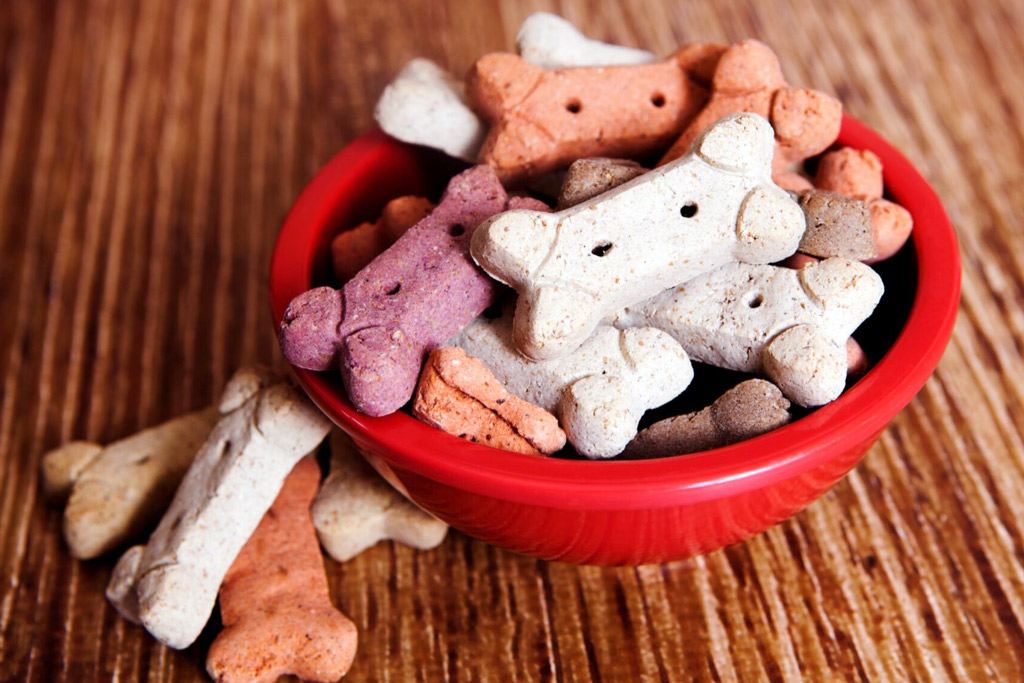
Dog Nutrition Costs
Research by the People’s Dispensary for Sick Animals (PDSA) found that 98% of pet owners underestimated the lifetime costs, with 12% (2.6 million) of dog owners putting it at £500 when the true cost is between £21,000 and £33,000 depending on size and breed. With dogs generally living for 10-13 years, that adds up to £2,000 or more a year.
Food is one of the biggest outgoings. There are lots of options – some people are passionate about raw meat, others opt for dry kibble, and then there are various tins and sachets. However, a report by Which? found that spending more on premium dog food does not guarantee that it is any more nutritious.
Insider Tip: You can combine different types of dog food to keep your dog’s diet balanced and avoid going over your budget.
How to Source Dog Food
To get started, you can contact or research dog food manufacturers to know for sure whether the food you’re buying is from ethically raised animals and the ingredients they use.
Usually, companies that go through the effort to make non-toxic, human-grade, non-GMO food discuss it extensively on their website. There they offer all the transparency you need to feel confident in feeding their food, including their certifications.
Ultimately, however, the best way to know what’s going into your dog’s food is to make it yourself. Making your dog’s food yourself means you can select ingredients.
How to Save Money on Dog Food
Food should be selected based on the quality factor. In addition, here are some ideas to reduce cost without compromising your dog’s health. 🙂
#1 – Buy Unbranded Food
Going for unbranded dog food will also cut costs if the ingredients are quite similar. Compare the ingredients for yourself and decide which option is best.
#2 – Homemade Treats
Rather than cutting out unnecessary treats, you could make your own. Learn more about healthy dog treat ideas in our blog post. Also, you can check my favourite dog treats post for healthy alternatives.
#3 – Buy In Bulk or Subscription
Buying your dog supplies, including food, in bulk could save you as much. Just make sure you have the room to store it, and do research or ask your vet for advice if you’re thinking of buying online if it’s a brand or retailer you know nothing about. Also, you can subscribe to a service to getting a monthly delivery.

Finally, if you want to know more about dog care, check out our The 5 pillars to a happy and healthy dog blog post.
